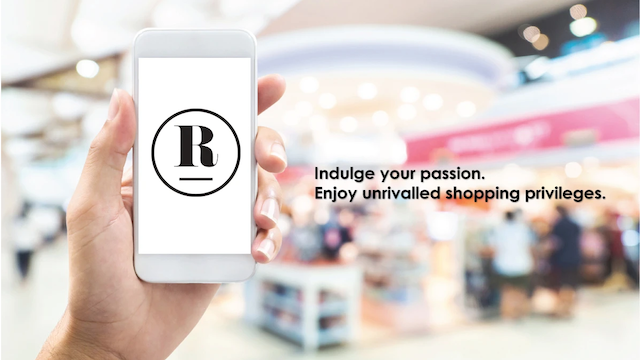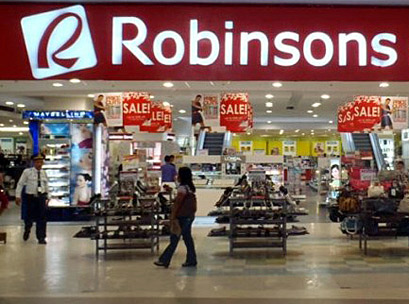Singapore-headquartered department-store chain Robinsons has built a 120,000-strong loyalty programme database in just 18 months using an app-based solution.
The programme, called R, is signing up new customers every day through interactions with customers of the company’s five stores in Singapore and Malaysia.
The 161-year-old department store has reinvented its customer relationship strategy since teaming with Capillary Technologies to develop the app and associated data management and interpretation activities.

Danny Lim, Senior GM at Robinson, said the programme evolved because the store wanted to communicate and interact better with its customer base than previous credit-card anchored loyalty programmes allowed. The application can be used by OCBC Robinsons Group Visa Card Members and Private Label Card Members and those signing up directly to the app, called ‘R-Listers’.
“We really needed to have more flexibility to reach out to our customers in the way that best resonates and works well with them,” Lim told Inside Retail Asia. “So through Capillary, we undertook a couple of initiatives towards integrating our customer base. And today we’ve got a relatively much more robust programme that we are taking to the next level, year by year.”
Charuvagun S, who is regional director Southeast Asia for customer success at Capillary, said the two companies decided a mobile application was the best way to start improving engagement with customers.
As a department store, Robinsons has hundreds of brands it is constantly trying to share news about with its customers – and shoppers in general. The app enables people to learn what is new in stores, something difficult or costly to achieve through traditional media like newspapers.
At the same time, the company is building a rewards programme so people can acquire points and then spend them on items from a catalogue of products.
“The mobile application has a lot of content in it that the consumer can interact with. They can look at the different brands available in the department stores, learn more about the brands and also understand where they are on the loyalty journey, how many points they have, and what they can do with those points.”
To build interest in the programme the app highlights a catalogue of items which they can redeem points to buy.
“So the idea was to make the engagement stronger, not just through push mechanisms, which are traditionally used – and we continue to use EDMs and SMS notifications – but also for customers,” said Charuvagun S. “Whatever they want to know about Robinson’s they can use the app to find out.”
The app was an immediate success upon launch. Robinsons’ customer-acquisition rate rose four-fold, from around 1000-1200 per month to 5000. Within 12 months, 60,000 customers had installed it on their phones.
Perhaps the most significant measure of the app’s success is the spending behaviour of members. The average transaction value of members is running at 25 per cent more than that of non members, and there was a 25-per-cent increase in the average basket size.
Lim says a positive spinoff from developing the programme is the additional insights into their customers’ shopping behaviour, such as how much they spend by demographic group and what promotions or communications they are responding to. An early lesson was recognising that the retailer did not offer as many reward options for customers wanting to redeem their points as they should have had.
“It was really important for us to be able to quickly react to this and increase our offering,” said Lim.
He believes that upgrading the reward system and developing a custom app for the business is an important step in preparing for future trends in digital commerce and customer relationships. He feels there is a lot of hype surrounding e-commerce when consumers are increasingly turning to mobile commerce: people are using their mobiles to shop, or they are viewing websites on their phones rather than a computer.
“There needs to be a lot of synergy in terms of omni channel, of having a physical store presence and also really connecting to the digital world itself. E-commerce also serves as a marketing platform, aside from a selling channel.”
Charuvagun S agrees. “One of the challenges that retailers are facing is that there is this big movement of different technologies coming into the picture, of different solutions in the market. Being able to choose what is the right technology that fits into the overall plan and how the technology is to be leveraged to continue the brand story as well as improving the customer experiences is key.
“Somebody has to have a good understanding of retailers, to understand the whole ecosystem and to bring solutions that fit into the brand story. Also, like with so many things around, prioritisation becomes key. Having a crawl-walk-run strategy and a six-month plan every half year to see what is to be implemented so as to learn more from those six months and take that feedback into the next six months; to continuously improve on the journey itself. That digital transformation journey itself becomes key.”
The next step for Lim is to integrate the rewards program app with the e-commerce platform so the entire pathway is seamless and that customers can buy products via the app.
Charuvagun S says the current rewards platform solution is focused on engagement. “It’s like having a salesperson sit inside a customer’s mobile phone to constantly engage the customer. Apart from that, we also bring data from different sources like transactional data, and other other data like NPS (net promoter score) survey data into the platform.”
Pulling that data and engagement together via machine learning can provide a lot of insights into the business which can be used to refine and improve communication with customers.
Capillary has also been running tests to see how the app can be used to create more engagement when customers are in store. During the Black Friday sales, for example, new offers were added every 15 minutes, which would run for limited time spans, such as 30 or 60 minutes.
Filtering is a key part of the app which Capillary says it will continue to develop.
“If you have a specific communication going out to customers to talk about a new product that is being launched, we can be specific, communicating only with customers who have bought similar products or a similar colour or a range of products. All these can be filtered,” says Charuvagun S.
“It is a tactical communication where we can reach exactly the segment of customers who would be likely to respond to such a campaign.
“What’s happening today is that with the different technology touch points that we have, we’re getting a lot of data about customers from multiple places. If you go to an e-commerce site, you get a lot of clickstream data. If you browse for 10 minutes on an e-commerce website, I’ll get 1000 data points about all that you have been doing on the side. And we get a lot of data from social media on what you’re saying about the brand, whether you are talking good things or not, if you like the brand pages, etc. That is the other data that we are getting from social media.
“Then, we also get transactional information from what you do in the retail store and on other e-commerce sites. The challenge now is how do we make all this data actionable.”
Charuvagun S says the software should be able to ascertain what products customers are interested in on the site, down to the colour and specific features. That information should enable a personalised communications to a customer talking specifically about those products.
“That’s the key to how you leverage all the data that is coming into the system, in terms of providing that insight to the marketing team so it can take action, or to automate the action.”
That, he says, is the focus area for both Capillary and Robinson’s during the coming months.






